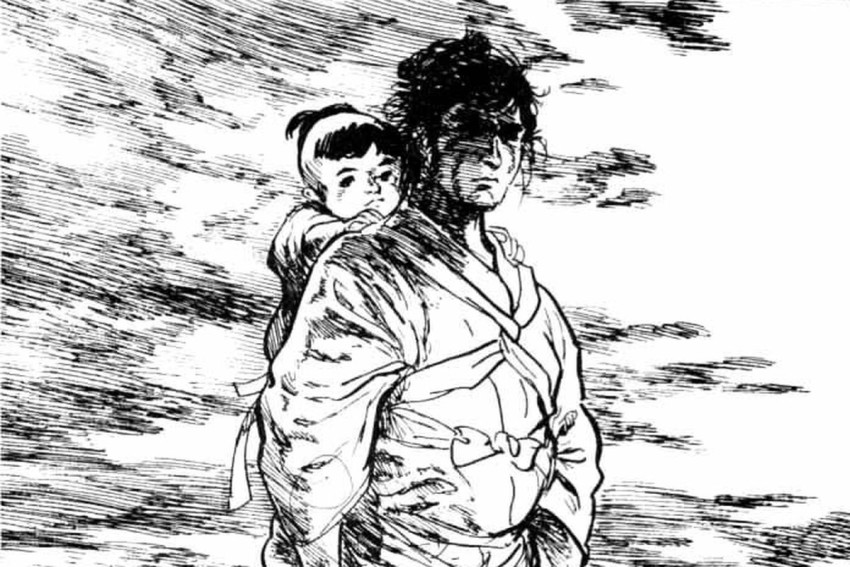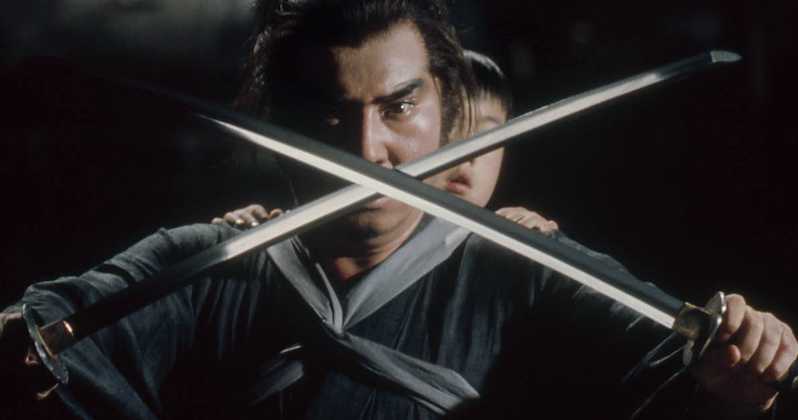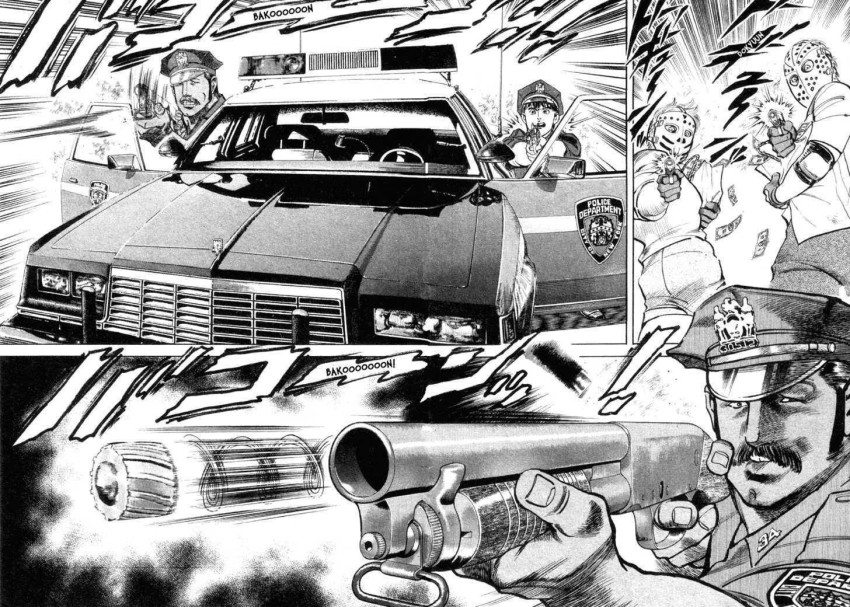Kazuo Koike (1936-2019)
April 19, 2019 · 0 comments
 Kazuo Koike, who died on 17th April, was a man of many names. Born Yuzuru Tawaraya in what is now Daisen, Akita Prefecture, he died as Seishu Tawaraya, a Buddhist name, and wrote song lyrics as Fumihiko Azuma. But as a writer, it is the Koike pen-name that found him the greatest fame, in a career spanning four decades. Koike’s career as a lyricist was less widely publicised, but in that mode, he wrote the words to the theme songs to several iconic shows, including Mazinger Z, Great Mazinger, and Science Sentai Dynaman.
Kazuo Koike, who died on 17th April, was a man of many names. Born Yuzuru Tawaraya in what is now Daisen, Akita Prefecture, he died as Seishu Tawaraya, a Buddhist name, and wrote song lyrics as Fumihiko Azuma. But as a writer, it is the Koike pen-name that found him the greatest fame, in a career spanning four decades. Koike’s career as a lyricist was less widely publicised, but in that mode, he wrote the words to the theme songs to several iconic shows, including Mazinger Z, Great Mazinger, and Science Sentai Dynaman.
In the austerity era of post-war Japan, the young Koike’s specialty was going into bookstores, reading manga off the shelves without buying them, and then returning to the schoolyard to act them out for his friends. It was an early manifestation of a storyteller’s craft that would serve him for the rest of his life. Koike began law studies at Chuo University in 1959, although his heart plainly wasn’t in it – his biographies already mention him being “mentored” by the period novelist Kenichiro Yamate, and his own recollections seemed to hinge more on the kendo club than the classroom. Failing the legal exams three times, he drifted into an authorially character-building series of odd jobs, including working at a mah-jong parlour, crewing freighters overseas, working for the Ministry of Agriculture and Fisheries, and assisting at a golf course.
In 1968, he wrote a spec script after reading in Shonen Magazine that Saito Production was looking for new authors. The fact that Koike was in his thirties and still reading a magazine for teenagers was a symptom of the times: Saito Pro was looking for adult scenarists to write adult stories for the generation of readers like Koike who didn’t want to leave comics behind when they grew up. He ended up working for Saito Pro on several titles, including its flagship Golgo 13, before going independent in 1970.
In 1972, he started Studio Ship with several other creators, a manga mill that churned out multiple stories and pages. Now known as Koike Shoin (the Koike Salon), the collective became an influential powerhouse in 1970s manga for men. Its biggest splash was undeniably Lone Wolf and Cub (1970-76), drawn by Goseki Kojima, the tale of a vengeful samurai who wanders Japan in search of his wife’s killers, incongruously pushing his infant son’s pram. Spanning 28 volumes and selling eight million copies, it was adapted into six films and a TV series. It was also hence perfectly placed at the beginning of the 1980s to attract the attention of foreign customers, becoming an early video hit (most memorably as the hacked-up and retitled Shogun Assassin) and one of the first manga to be translated into English.
 “The 1970s in Japan was an era rife with student protests,” Koike told Carl Gustav Horn. “There was a lot of anguish in the air towards public policy. The state was threatened by these movements, and attempted to limit freedom of expression. There was a lot of resistance and overall, people were very angry. The mood in the air affected manga creators as well in the subject and content of their work. And I was not an exception. That’s why I created this character and book.”
“The 1970s in Japan was an era rife with student protests,” Koike told Carl Gustav Horn. “There was a lot of anguish in the air towards public policy. The state was threatened by these movements, and attempted to limit freedom of expression. There was a lot of resistance and overall, people were very angry. The mood in the air affected manga creators as well in the subject and content of their work. And I was not an exception. That’s why I created this character and book.”
Lone Wolf and Cub’s footprint in the overseas art world was legendary – it was cited by Frank Miller as a major inspiration, and recast by Max Allan Collins as his extended Prohibition-era pastiche, The Road to Perdition. Most recently, Justin Lin has announced a remake in development. The manga won him an Eisner Award in 2001, but it also formed a template for many of his subsequent works, including Samurai Executioner, serialised in Shukan Gendai from 1972-76, featuring the same artist and often, it seemed, the same plots.
Similarly successful in both manga and movie forms was his Lady Snowblood, drawn by Kazuo Kamimura, serialised in Weekly Playboy from 1972-73. With a Japanese title that punned on both Snow White and the Buddhist concept of carnage, it told a generation-long story of vengeance, in which a woman is jailed for killing one of the murderers of her husband and son, gives birth in prison to a daughter, and then raises that daughter to hunt down the rest of the criminals on the outside. Released in an era when the flight to the suburbs was turning urban cinemas into the preserve of young, single males, Lady Snowblood also enjoyed a long tail of influences, culminating in Quentin Tarantino’s Kill Bill. It continues to echo in many manga for the male gaze that mix a cocktail of violence and female nudity, most recently in Eldo Yoshizaki’s Ryuko (2015).
Perhaps drawing on his own decade in the wilderness as a college dropout with few prospects, Koike’s concentration on revenge and payback had an enduring appeal to the marginalised male reader, righting perceived wrongs, seething over dreadful slights, and having one’s cake and eating it when it came to violence against women – you could be sure it would be avenged, but not before the victim’s suffering was also presented in lurid detail. But if his works often seemed to strike a single note, it was arguably because he had found a readership that resonated with a particular mode of storytelling. As a teacher, at first of his own Gekiga Cram School, then at several higher education institutions, he would shepherd a roster of widely differing students to the market. Former pupils of Koike’s include the horror novelist Hideyuki Kikuchi, but also Naoki Yamamoto, the creator of gentle romances, and the eclectic Rumiko Takahashi, creator of Urusei Yatsura and Inu Yasha.
https://www.youtube.com/watch?time_continue=9&v=y08ZO-4q9Lw
“I’ve only been teaching how to develop characters,” he told Horn, “never how to construct a storyline. What I always try to do is persuade my students to create a strong character first. If you have a strong character, the storyline will develop naturally, on its own. The storyline then follows in the character’s wake, and swirls around the character, influencing the character further… Strong manga can only be made when you create a strong character. I’ve never changed my ground on this philosophy. If you’re wondering how I teach my students to create good characters – to give them that starting point – I try to encourage them to make two characters that are polar opposites: God and Satan, night and day, North Pole and South. The struggle between these two characters develops the story. Having just one strong character doesn’t work. Having two characters as foils of each other is what sets things in motion.”
Koike’s own work, unfailingly loaded with sex and violence, became a common feature of early manga in the west, with Viz Communications picking up his Chinese gangster epic Crying Freeman, which originally ran in Big Comic Spirits from 1986-88. The title character is an assassin for the 108 Dragons triad, eventually revealed as a gentle potter, brainwashed by the organised crime syndicate to carry out killings on their behalf. The last vestiges of his true character are revealed by his habit of weeping after each murder, although the true star of Crying Freeman was arguably not its elite assassin, but the gamine heroine Emu Hino. Scheduled for elimination before she can testify as a witness to one of the killings, she demands that Freeman take her virginity before he kills her. Freeman is subsequently unable to pull the trigger, and the couple end up marrying and becoming a murderous double-act, with Emu wielding a cursed Muramasa blade.
 Koike was always very good at being bad, no more obviously than in his infamous Mad Bull 34 (1986-91), drawn by Noriyoshi Inoue, a loving pastiche of American police procedurals, taking the very worst of crime and thrillers to present New York as a dangerous urban jungle, and the police as little more than a good-hearted gang. The story was also notorious in its anime spin-off, in which a ruthless cop hunted down the assassin who has already tried to kill him with poison soap, in revenge for the death of the prostitute they shared on alternate weekdays. Apologists for Mad Bull 34 plead that its intention was always ironic and satirical, a light-hearted ribbing of the way that American media looks to the outside world, but like much of Koike’s work, while it is undeniably a masterpiece of what it wants to be, it is sure to be found puerile, icky and frankly triggering by many modern readers.
Koike was always very good at being bad, no more obviously than in his infamous Mad Bull 34 (1986-91), drawn by Noriyoshi Inoue, a loving pastiche of American police procedurals, taking the very worst of crime and thrillers to present New York as a dangerous urban jungle, and the police as little more than a good-hearted gang. The story was also notorious in its anime spin-off, in which a ruthless cop hunted down the assassin who has already tried to kill him with poison soap, in revenge for the death of the prostitute they shared on alternate weekdays. Apologists for Mad Bull 34 plead that its intention was always ironic and satirical, a light-hearted ribbing of the way that American media looks to the outside world, but like much of Koike’s work, while it is undeniably a masterpiece of what it wants to be, it is sure to be found puerile, icky and frankly triggering by many modern readers.
If critics expected the aging Koike to tone down his excesses in the 1990s, they were going to be disappointed. Auction House, drawn by his long-time Studio Ship-mate Seisaku Tamura and running in Business Jump from 1990 to 2003, featured the world-class art appraiser Liu Songyan, and appeared at first to enter a world of conspicuous consumption and antiques trading. Except, of course, Liu is also an assassin hell-bent on vengeance against the trio of men who killed his parents in a tussle over Vermeer’s painting The Lacemaker, less Lovejoy with a flick-knife, more James Bond with a gavel. The fight scenes were inevitably visceral, the ladies eternally disposable and interchangeable, rendered with centrefold care.
At the end of his career, Koike basked in the attention garnered by an influential career in the world of men’s comics – a Mad Bull sequel was serialised in a magazine called All Man, which artfully summarises his self-image. He was a big-name guest writer for Marvel on Wolverine and The Hulk, a recurring pundit on Japanese chat shows, and an ever-present golfing expert in numerous venues of publication and broadcast. His name was one of the most familiar to many a 1980s manga fan in the West, although one gets the impression that sometimes he was lauded as an artist, by fans who had not realised that he did the words. Along with his sometime collaborator and occasional rival Monkey Punch, he was a star of the old-world era of comics for men, making him part of the very establishment against which the women’s manga of the 1980s and beyond deliberately reacted against. But as Koike himself would have noted, everybody needs an opposite.
“For Japanese manga, that’s the first stage,” he once said. “A good character. Who do you think are the greatest characters in history? I teach that the greatest character of all time is Jesus Christ, and the second is the Devil. The third? Buddha.”
Leave a Reply